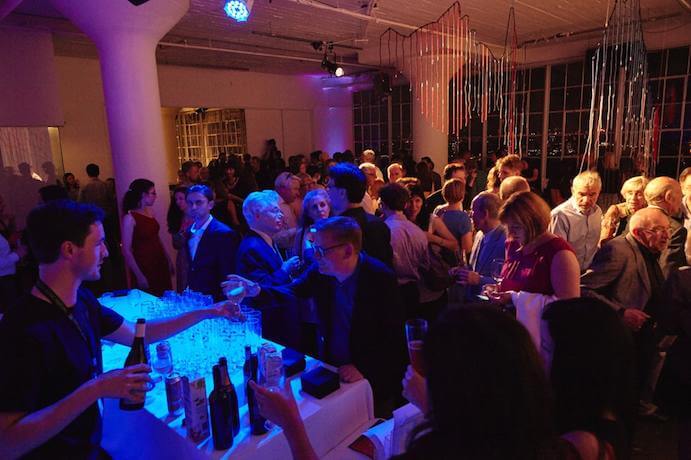The Chelsea Music Festival’s Opening Night Gala took place at Canoe Studios, a warehouse practically falling into the Hudson River on West 26th Street. The panoramic view of the sunset and the blues of Freedom Tower were just surreal enough to complement June 12, 2015’s kaleidoscopic program of Finnish and Hungarian music. Nestled in the unique mix of Chelsea’s gallery, warehouse, and religious spaces, the Festival invites audiences into normally inaccessible areas. Its programming often features important composer anniversaries or birthdays, and each Festival season uses music as an entry point to explore the historical, culinary, and cultural distinctions of a few countries. A broad and multi-disciplinary scope of events– late-night jazz, kids’ education, cultural expert panels, art installations, composer interviews– create an immersive gateway to hear, taste, and see music. Taste is key– the Chelsea Music Festival (CMF) knows good food. Each year, it invites a Culinary Artist-in-Residence to model creative response to music with a menu reflective of the featured cultures.

World Premiere of Ilari Kaila’s Cameo– Photo by Matt Harrington
CMF is committed to musical education and emerging composers. Programming often features rarely performed early works of popular composers, like the program’s opening Sibelius Piano Quartet in C Minor that evolved from his earlier Theme and Variations in C Minor. Each Festival season also gives a platform for a Composer-in-Residence to bring their work to the attention of New York City. During the 2015 season, there is a World or New York City Premiere every night, and the Opening Gala featured a world premiere of “Cameo” for flute, piano, and viola by this year’s Composer-in-Residence, Ilari Kaila. The piece was an honest structure carefully built and unwound with precision. The uniqueness of the instruments was highlighted and utilized in surprising ways. Although the piece opened with solo flute, any insinuations of sentimentality were quickly discarded: Kaila’s flute didn’t flutter in its opening statements but conversed with itself in loops, spearing the top notes of half-step intervals. Instead of floating above the other two instruments in predictable loveliness, flutist Malla Vivolin brought angularity; rather than being overpowered by the piano, she dueled as an equal and formidable presence. Even during the piano’s aggressive moments, it conceded to the equality of the flute. Kaila’s writing for the piano allowed Emil Holmström to play with its timbres like an architect using insistent trills, condensed chords, and jackhammer repeated notes to build space. There wasn’t a standout moment that highlighted the viola’s warmth, and Derek Mosloff flowed consistently underneath the piano and flute’s forceful presence like a peaceful liaison. Without him, the trio’s discourse would have fallen apart. Kaila’s music showcased a traditional inheritance being purposed toward modern discovery.
After Kaila’s piece, it seemed like a forest of string players grew on the stage. Six violinists, two violists, three cellists, and three bassists swarmed into the front of the room for Andante Festivo by Sibelius and Finnish Myth by one of his successors, Einojuhani Rautavaara. The same acoustics that marred the program’s opening piece amplified Festivo’s sheer joy. The performers’ faces were as vibrant and celebratory as their music; so many strings in such simple, elegant melody! Rautavaara’s piece highlighted not the beauty of the unified strings but their division, pulling an elegant palette of sound from the instrument family by traditional and modern techniques. The celli and double bass opened in tremolo of magnetic, focused power, heralding the narrative scope that was built through pizzicato, spidery dissonance, thick bass underpull, and climactic soaring into a violin quartet. The work truly brought a mythical Finnish soundscape to life.
Chelsea Music Festival Opening Gala– Photo by Matt Harrington
The program finished with Piano Quintet, BB 33, DD 77, one of Bartók’s final works before he fixated on Hungarian folk music. Bartók couldn’t keep his own modernity out of the writing, though, and his future trademarks bled through. After two Straussian movements, Derek Mosloff on viola and second violinist Amy Galluzzo introduced surprising folksy snatches of melody. The otherwise traditional string writing grounded the constant rhythmic changes, creating the impression of boundless energy and a prize to be won. Tessa Lark on first violin led the quartet into the fray, and even in the overheated room they gave an athletic and heartening performance with all the dexterity needed to turn on the dimes of Bartók’s many moods. Nicolas Namoradze’s piano was a consistent and glassy contrast to the volatile and vibrant string quartet; each musician’s agile technique executed the piece genuinely but without sentiment, and cellist Michael Dahlberg’s occasional heartfelt lines were refreshing and sincere.
Afterwards, the audience celebrated with Chef-in-Residence Sami Tallberg’s four-course menu “Tastes from the Mythic Forest.” Ingredients like wild mushrooms, sea buckthorn, bee pollen, and chamomile marinade from a local forager complemented the mythical music just performed and gave insight into the wild natural habitat Finns embrace. Curious new tastes were a fitting way to close the evening: both the Festival and its featured composers excel at fashioning local elements into wild and wonderful experiences.

